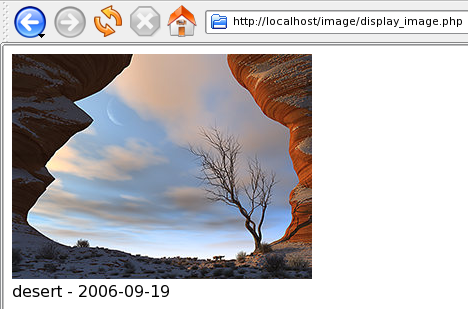How to store images in Postgres using Php.
Published - Sep 16/2006
Last Updated - Apr 24/2008
Author - Sumedh
Uploading the image
File Name - image.php
<?php
$uploaddir = '/home/postgres/';
$uploadfile = $uploaddir . basename($_FILES['userfile']['name']);
$name = $_POST['name'];
if (move_uploaded_file($_FILES['userfile']['tmp_name'], $uploadfile))
{ // echo "File is valid, and was successfully uploaded.\n";
}
else { echo "File size greater than 300kb!\n\n"; }
echo "'$name'\n";
$conn = pg_pconnect("dbname=test user=postgres password=postgres");
$query = "insert into image values ('$name', lo_import('$uploadfile'), 'now')";
$result = pg_query($query);
if($result)
{
echo "File is valid, and was successfully uploaded.\n";
unlink($uploadfile);
}
else
{
echo "Filename already exists. Use another filename. Enter all the values.";
unlink($uploadfile);
}
pg_close($conn);
?>
<?php
$uploaddir = '/home/postgres/';
$uploadfile = $uploaddir . basename($_FILES['userfile']['name']);
$name = $_POST['name'];
if (move_uploaded_file($_FILES['userfile']['tmp_name'], $uploadfile))
{ // echo "File is valid, and was successfully uploaded.\n";
}
else { echo "File size greater than 300kb!\n\n"; }
echo "'$name'\n";
$conn = pg_pconnect("dbname=test user=postgres password=postgres");
$query = "insert into image values ('$name', lo_import('$uploadfile'), 'now')";
$result = pg_query($query);
if($result)
{
echo "File is valid, and was successfully uploaded.\n";
unlink($uploadfile);
}
else
{
echo "Filename already exists. Use another filename. Enter all the values.";
unlink($uploadfile);
}
pg_close($conn);
?>
The image file has to be uploaded to a temporary directory on the server where the user ( postgres in this case ) has read write access. Php then stores the image in postgres from the temporary directory . The $uploaddir variable stores the path of that temporary directory. The $uploadfile variable contains the path as well the filename. The 'move_uploaded_file' function moves the user selected file to the temporary directory. If the file is valid you won't get any errors.
Php then connects to the postgres database and uploads the file with lo_import. lo_import reads the specified file and places the contents into a large object.
Note - If your dbname, user and password are different, change the 'pg_connect' function by adding your own entries.
The display form
File Name - display.php
<html>
<head><title>File Upload To Database</title></head>
<body>
<h3>Enter the filename and click Submit</h3>
<form action="display_image.php" method="post">
<input type="text" name="name" size="25" length="25" value="">
<input type="submit" name="submit" class="button" value="Submit">
<input type="reset" name="reset" class="button" value="Clear It">
</form>
</body>
</html>
<html>
<head><title>File Upload To Database</title></head>
<body>
<h3>Enter the filename and click Submit</h3>
<form action="display_image.php" method="post">
<input type="text" name="name" size="25" length="25" value="">
<input type="submit" name="submit" class="button" value="Submit">
<input type="reset" name="reset" class="button" value="Clear It">
</form>
</body>
</html>
Enter the name of the file which you want to view and which you have already stored in the database. We have to type an image name because we dont want to do something silly like 'select * from image'

The above form takes the name from the user and gives it to an another script which retrives the selected the image from the postgres database. Make sure the name you enter is present in the database as we have not added any error checking code.
Displaying the image
File Name - display_image.php
<?php
$conn = pg_pconnect("dbname=test user=postgres password=postgres");
$name = $_POST['name'];
$temp = '/home/postgres/tmp.jpg';
$query = "select lo_export(image, '$temp') from image where name = '$name'";
$result = pg_query($query);
if($result)
{
while ($line = pg_fetch_array($result))
{
$ctobj = $line["image"];
echo "<IMG SRC=show.php>";
printf ("<br/>".$line["name"]." - ".$line["day"]." ");
}
}
else { echo "File does not exists."; }
pg_close($conn);
?>
<?php
$conn = pg_pconnect("dbname=test user=postgres password=postgres");
$name = $_POST['name'];
$temp = '/home/postgres/tmp.jpg';
$query = "select lo_export(image, '$temp') from image where name = '$name'";
$result = pg_query($query);
if($result)
{
while ($line = pg_fetch_array($result))
{
$ctobj = $line["image"];
echo "<IMG SRC=show.php>";
printf ("<br/>".$line["name"]." - ".$line["day"]." ");
}
}
else { echo "File does not exists."; }
pg_close($conn);
?>
$_POST['name'] contains the name which you entered. $temp contains the path of a temporary file where the retrieved image is stored. 'lo_export' is a postgres function which gets the file which you want from the image table and saves it in the temporary file.
But its not over yet. We have to display the file in the browser. For that we need another script which reads the file from the temporary location and displays it in the browser. Why do we need another script to display the image? Its because a request for an image is a separate HTTP request. An image is its own web page. Hence we need a script to output 'JUST' the image.
The image script
File Name - show.php
<?php
header("Content-type: image/jpeg");
$jpeg = fopen("/home/postgres/tmp.jpg","r");
$image = fread($jpeg,filesize("/home/postgres/tmp.jpg"));
echo $image;
?>
<?php
header("Content-type: image/jpeg");
$jpeg = fopen("/home/postgres/tmp.jpg","r");
$image = fread($jpeg,filesize("/home/postgres/tmp.jpg"));
echo $image;
?>
The header tells the browser what kind of file it tries to download. The fopen function opens the selected file and places a file pointer at the beginning of the file in the $jpeg variable. The fread function reads up to length bytes from the file pointer where length represents the size of the file.
Final output

Page 1 2
All rights reserved, Sumedh K
